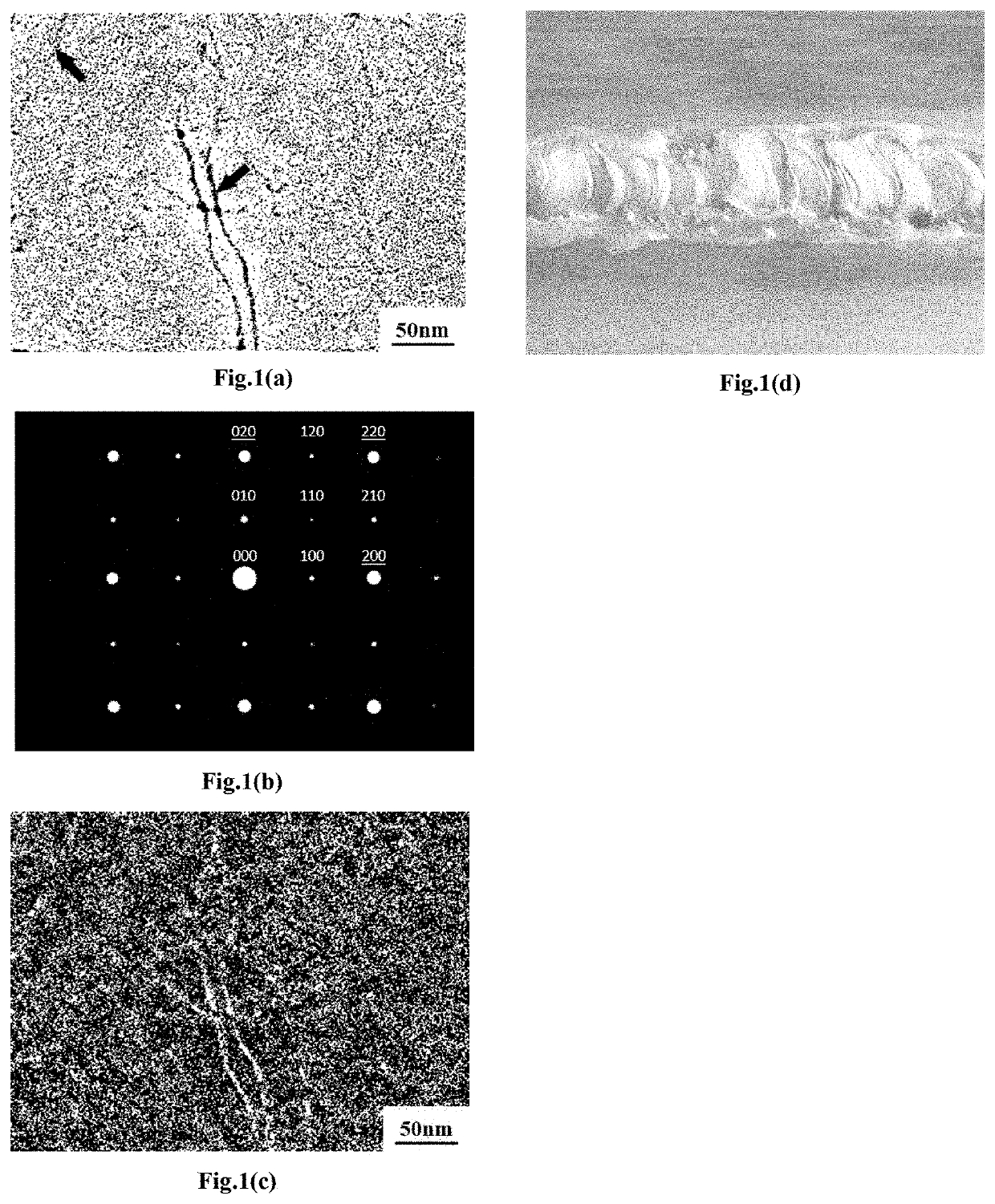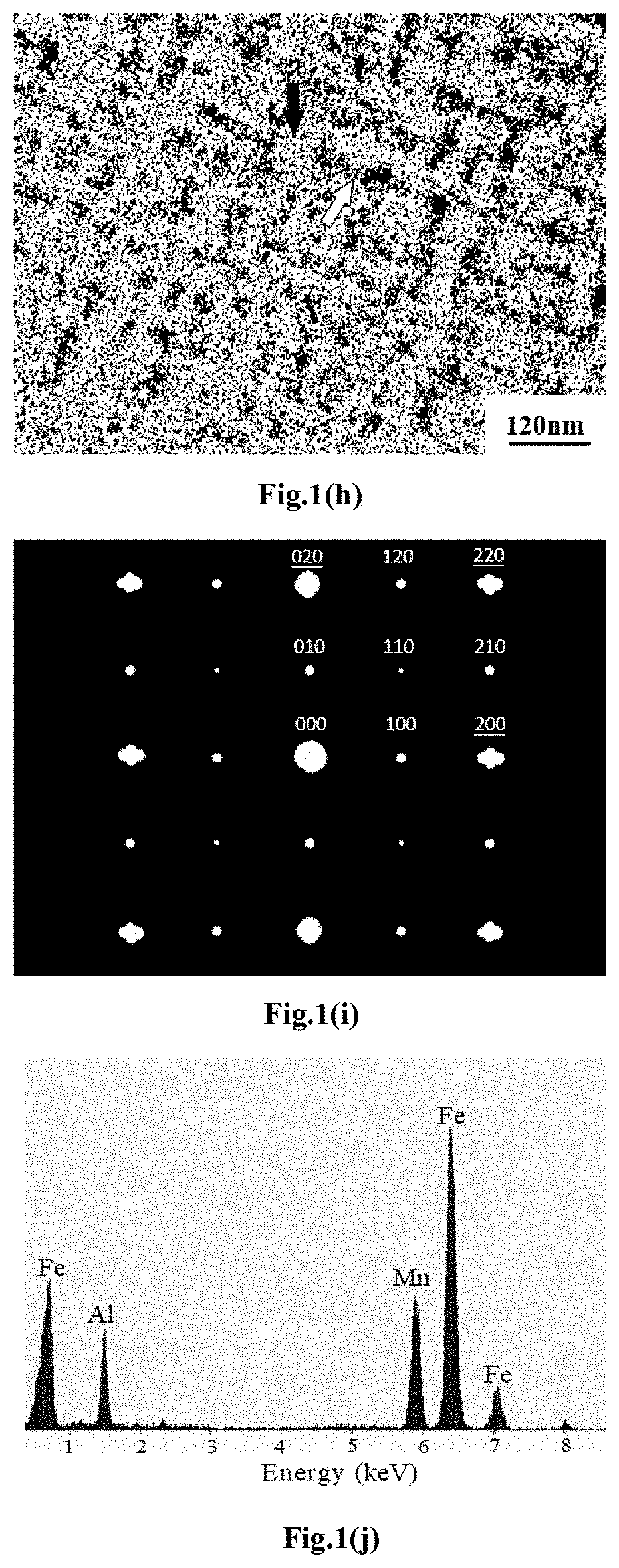WELDING FILLER WIRE FOR FUSION WELDING PRECIPITATION-HARDENED AUSTENITIC Fe-Mn-Al-C ALLOYS
- Summary
- Abstract
- Description
- Claims
- Application Information
AI Technical Summary
Benefits of technology
Problems solved by technology
Method used
Image
Examples
example 1
[0136]FIG. 1(a) is the TEM bright field (BF) image of an as-hot-rolled Fe-28.5Mn-9.0Al-1.55C base material, showing a high-density of nano-sized (˜3-5 nm) precipitates uniformly distributing within the matrix. Also noted that, as indicated by the arrows shown in FIG. 1(a), the precipitates existing on the dislocations are slightly larger in size (˜5-8 nm), suggesting that these precipitates were formed during the hot-rolling process. FIG. 1(b), the selected-area diffraction pattern (SADP) of the as-hot-rolled base material, demonstrates that the high-density of nano-sized precipitates are (Fe,Mn)3AlC carbides (κ-carbides) having an L′12-structure. FIG. 1(c) shows the (100)K dark field (DF) image of the same area as displayed in FIG. 1(a) to illustrate the presence of the κ-carbides within the austenite matrix and on the dislocations. It is clear that the as-hot-rolled microstructure of the base material used in the present embodiment is single-phase austenite with uniformly distribu...
example 2
[0142]The purpose of the present Example attempts to clarify the effects of altering the carbon content in the welding filler wire on the characteristics of FZ in the as-welded sample. The base material used in this Example was the same as that used in Example 1. However, the GMAW welding process was employed in this Example. The dimensions of the BM plates were 80 mm×80 mm×12 mm, which were machined to form a single V-groove butt weld. The GMAW welding process was carried out with a voltage of 26 V and current of 140˜170 A. The flow rate of the shielding gas (25% Ar+75% He) was ˜18 liters / min and the welding filler wire feeding speed of was ˜200 mm / min, respectively. The nominal composition of the welding filler wire used in the present Example was Fe-28.2Mn-9.2Al-1.72C with a wire diameter ϕ˜1.2 mm.
[0143]FIG. 2(a) shows the macroscale image of the GMAW welding bead. It can be seen from FIG. 2(a) that the bead appears to have a very smooth morphology with no visible macrocrack and ...
example 3
[0147]In this Example, we investigated the effects of a slightly lower carbon content on the characteristics FZ in the as-welded sample. An as-hot-rolled base material with nominal composition of Fe-28.8Mn-8.9Al-1.62C was used in the present Example of embodiment. FIG. 3(a) is the TEM BF image of the hot-rolled base material. It is evident in FIG. 3(a) that the as-hot-rolled microstructure of BM used in the present Example is quite similar to that used in Example 1 and Example 2. Namely, there is a high-density of nano-sized (˜3-5 nm) precipitates uniformly distributing within the matrix and on the dislocations (as indicated by the arrows). FIG. 3(b) is the selected-area diffraction pattern (SADP) of the as-hot-rolled base material, which evidently confirms that the matrix of the base material is fully austenitic and the high-density nano-sized precipitates are the ordered L′12-structured κ-carbides. FIG. 3(c) is the (100)K DF image taken from the same area as displayed in FIG. 3(a)...
PUM
| Property | Measurement | Unit |
|---|---|---|
| Fraction | aaaaa | aaaaa |
| Fraction | aaaaa | aaaaa |
| Fraction | aaaaa | aaaaa |
Abstract
Description
Claims
Application Information
 Login to View More
Login to View More - R&D
- Intellectual Property
- Life Sciences
- Materials
- Tech Scout
- Unparalleled Data Quality
- Higher Quality Content
- 60% Fewer Hallucinations
Browse by: Latest US Patents, China's latest patents, Technical Efficacy Thesaurus, Application Domain, Technology Topic, Popular Technical Reports.
© 2025 PatSnap. All rights reserved.Legal|Privacy policy|Modern Slavery Act Transparency Statement|Sitemap|About US| Contact US: help@patsnap.com



